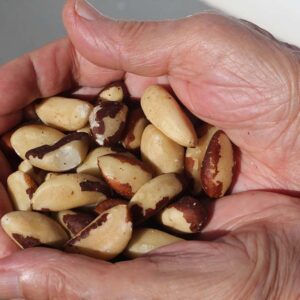
Warning: This Popular Sweet May Be Poisoning You
- One of America’s most loved desserts has a toxic secret
- Sugar is not your only concern when it comes to this indulgence. Find out what is lurking in your dessert
- One list that can make or break your confectionary decisions.
Dear Reader,
Every time you bite into your dessert, do you think, “Wow, these toxins taste wonderful?”
Well, maybe you should.
Recently, new evidence has surfaced that one of America’s most favored confections is chock-full of contaminants.
And surprisingly, I’m not talking about sugar.
Data from the National Confectioners Association shows that most Americans are enjoying this treat twice a week.1
And this sweet is so popular that the average American consumes 9.5 pounds of it annually.2
Not to mention this dark and delicious food has weaved its way into all types of foods, from cakes, cookies, and candies to savories like bacon and mac ’n’ cheese.
If you haven’t guess it yet, I am talking about chocolate — and it’s nearly impossible to escape it in the modern dietscape.
![]() Death by Chocolate
Death by Chocolate
Well, maybe death is a little extreme…
But these new results do show that chocolate consumers are at risk for some pretty serious health issues — especially children.
Last month, a California-based consumer health watchdog group called As You Sow found many of the big-name chocolate companies are selling products riddled with toxic heavy metals.
These metals include cadmium and lead.
Lead exposure is associated with multiple health issues, including memory loss and declining mental functions in adults, but has even more devastating results in children.3
These include behavioral issues like increased antisocial behavior, reduced attention span, and even lower IQ in children. All of these negative health effects are thought to be irreversible in children.4
No level of lead is safe for children and pregnant women.
Cadmium exposures can lead to kidney damage and bone issues. Long-term intake of cadmium may lead to softening of the bones, osteoporosis, and cancer.5
When As You Sow conducted tests of 26 products in their single serving size three times, they found they all contained more lead and cadmium than allowed by California law.6
Among these were Godiva, Hershey, Mars, Trader Joe’s and Whole Foods brands.
Hershey’s director of corporate communications, Jeff Beckman, defended their products. In a statement to The Washington Post:
The [Food and Drug Association] and many states monitor the amount of cadmium and lead in food. All Hershey products meet all FDA and state standards, and our cocoa powder and chocolate are safe to eat. This includes the very strict Proposition 65 standards for lead and cadmium in candy and other products.1
He went on to say, “People have been eating cocoa and chocolate for centuries with no evidence of a single incident of concern regarding these naturally occurring minerals.”1
But researchers at the University of California Santa Cruz disagree. A study they published in Environmental Health Perspectives found that these high levels of lead found in chocolate are not from a natural source.
One of the researchers from the study, Russ Flegal, stated this about the possible sources:
The average lead concentration of cocoa beans was ≤ 0.5 ng/g, which is one of the lowest reported values for a natural food. In contrast, lead concentrations of manufactured cocoa and chocolate products were as high as 230 and 70 ng/g, respectively, which are consistent with market-basket surveys that have repeatedly listed lead concentrations in chocolate products among the highest reported for all foods. One source of contamination of the finished products is tentatively attributed to atmospheric emissions of leaded gasoline, which is still being used in Nigeria.
While the origin of these toxins is unclear, Elaine Van Vliet, director of toxic chemical research at As You Sow, thinks the contaminates may be coming in contact with the chocolate somewhere in the manufacturing process.
The folks at As You Sow filed legal notices demanding candy companies add warning labels to their current packaging for high levels of cadmium and lead.
If you would like to see the As You Sow’s list of contaminated brands, click here. If you continue to scroll down, there is also a list of “No Warning Required” chocolates. While these may not be some of your favorites, at least if gives you a few options.
In the meantime, you may want to consider subbing Jordan almonds for chocolate bunnies this spring.
Live Well,

Natalie Moore
Managing editor, Living Well Daily
Sources
[1] How much lead is in your chocolate?
[2] Americans eat HOW MUCH chocolate?
[3] Lead poisoning
[5] EXPOSURE TO CADMIUM: A MAJOR PUBLIC HEALTH CONCERN
Written By Natalie Moore
Natalie Moore is a dedicated health researcher with a passion for finding healthy, natural, and science-based solutions. After a decade of direct healthcare experience in western and natural medicine, she was involved in public health research before joining Living Well Daily.
View More Free Articles
Mailbag: Diarrhea Remedies That Really Work
“I have had diarrhea for 6 months. I’m going crazy and don’t know how to stop it! Please help!” – Can’t Stop Running Dear Can’t Stop, Few things disrupt life like battling a bout of diarrhea. Diarrhea is typically defined as having three or more loose, watery stools daily. If you experience this for over...
Take the SHORTER Path to Dramatically Better Health
Are you tired of fitness gurus preaching the virtues of 5 AM workouts and pushing Olympic-level training regimens? Their narrative can feel exhausting and entirely unattainable. But before you toss in the towel completely, I’ve got news that might just put a spring back into your step. A groundbreaking new study reveals that the key...
Unexpected Perks of Your Coffee Habit Revealed!
We all know that the first cup of coffee in the morning can FEEL like a lifesaver. But what if it might actually BE saving your life? A groundbreaking new study suggests that your daily coffee habit could be protecting you from not just one but multiple chronic diseases. Let’s pour over this fascinating research…...
The TRUTH About Diabetes Drugs and Brain Aging
You’ve probably seen the gushing headlines… Most say something like, “Common diabetes drug protects the brain against aging!” And let’s face it, that sounds fantastic. After all, who doesn’t want to keep their brain young and in tip-top shape? The headlines refer to the results of a new study that suggests the widely prescribed type...
Hidden Smartphone Danger Puts You at Risk
Remember when we thought cell phones were just something for young folks to obsess over? Back when we were convinced they were nothing more than a passing fad? Well, times certainly have changed. Now, most people… including many of us older folks… have jumped on the smartphone bandwagon. Heck, some of us are practically as...
Preserve Your Mobility with “Agile Aging” Exercises
Aging has a way of humbling us. You lose hair where you want to keep it—and often end up growing it where you don’t. With every passing year, your eyesight fades, and your waistline expands. And as your once quick pace begins to slow, you fear developing the dreaded “senior shuffle.” But here’s the thing....
Yes, Lazy Saturday Lie-Ins Can BOOST Your Health
Are you burning the midnight oil during the week and catching up on sleep on weekends? Well, I’ve got some news that might help you feel less guilty about those lazy Saturday mornings. A new study suggests that weekend lie-ins might be doing far more than just helping you feel refreshed. Experts say they could...
Mailbag: 7 Hidden Culprits Behind Your Weight Gain
“Why am I gaining weight, even though I am watching what I am eating?” – Battling the Bulge Dear Battling, Gaining weight when you’re not trying to is frustrating. And it just gets worse as we age… often regardless of our diet. The truth is that various factors can promote weight gain even when you’re...
Popular Artificial Sweetener Linked to Dangerous Heart Risk
Remember when erythritol was the darling of the health food world? Well, this popular sugar substitute might not be as sweet a deal as we were led to believe… A shocking new study reveals a dark side to this widely used artificial sweetener. It turns out erythritol is associated with a dangerous—and even deadly—heart risk....
Cracking the Code on Chronic Inflammation
Inflammation and obesity are the evil tag team at the heart of nearly every major disease we face—from diabetes to obesity. What starts as a normal, healthy process to fend off dangerous invaders can quickly fan into the flames of chronic inflammation… and that includes in your gut. The trouble is almost no one has...









